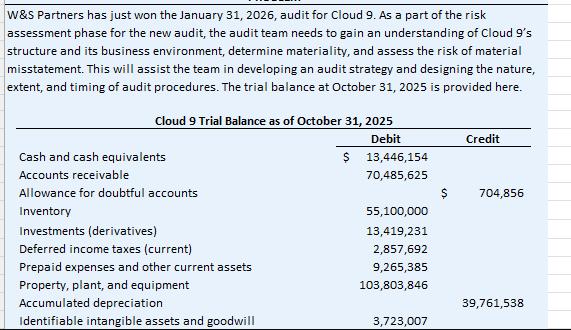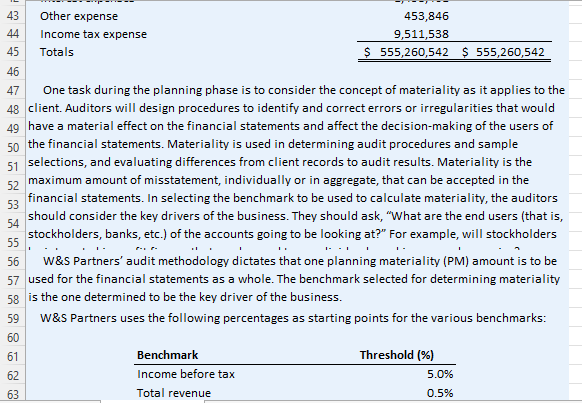Question: W&S Partners has just won the January 31, 2026, audit for Cloud 9. As a part of the risk assessment phase for the new





W&S Partners has just won the January 31, 2026, audit for Cloud 9. As a part of the risk assessment phase for the new audit, the audit team needs to gain an understanding of Cloud 9's structure and its business environment, determine materiality, and assess the risk of material misstatement. This will assist the team in developing an audit strategy and designing the nature, extent, and timing of audit procedures. The trial balance at October 31, 2025 is provided here. Cloud 9 Trial Balance as of October 31, 2025 Debit Cash and cash equivalents Accounts receivable Allowance for doubtful accounts Inventory Investments (derivatives) Deferred income taxes (current) Prepaid expenses and other current assets Property, plant, and equipment Accumulated depreciation Identifiable intangible assets and goodwill $ 13,446,154 70,485,625 55,100,000 13,419,231 2,857,692 9,265,385 103,803,846 3,723,007 Credit 704,856 39,761,538 22 Identifiable intangible assets and goodwill 23 Accumulated amortization 24 25 26 27 28 29 30 31 Income taxes payable Long-term debt Deferred income taxes and other liabilities (noncurrent) 32 Common stock at par value 33 Capital stock in excess of par value 34 Unearned stock compensation 35 Accumulated other comprehensive income Beginning retained earnings 36 37 Dividends 38 Repurchases of common stock Deferred income taxes and other assets (noncurrent) Current portion of long-term debt Notes payable Accounts payable Accrued liabilities 39 40 41 42 43 Revenue Cost of sales Selling and administrative Interest expenses Other expense 3,723,007 9,557,692 253,846 5,011,538 3,866,838 4,627,381 169,346,154 79,092,308 1,438,461 453,846 2,115,385 21,376,923 14,986,457 25,803,846 2,211,539 23,661,538 4,915,384 111,538 19,415,385 122,857,692 277,338,461 43 Other expense 44 Income tax expense 45 Totals 46 47 One task during the planning phase is to consider the concept of materiality as it applies to the 48 client. Auditors will design procedures to identify and correct errors or irregularities that would 49 have a material effect on the financial statements and affect the decision-making of the users of 50 the financial statements. Materiality is used in determining audit procedures and sample 51 selections, and evaluating differences from client records to audit results. Materiality is the maximum amount of misstatement, individually or in aggregate, that can be accepted in the financial statements. In selecting the benchmark to be used to calculate materiality, the auditors should consider the key drivers of the business. They should ask, "What are the end users (that is, stockholders, banks, etc.) of the accounts going to be looking at?" For example, will stockholders 52 53 54 55 77 I 56 W&S Partners' audit methodology dictates that one planning materiality (PM) amount is to be 57 used for the financial statements as a whole. The benchmark selected for determining materiality 58 is the one determined to be the key driver of the business. 59 W&S Partners uses the following percentages as starting points for the various benchmarks: 60 61 62 63 453,846 9,511,538 $ 555,260,542 $ 555,260,542 Benchmark Income before tax Total revenue Threshold (%) 5.0% 0.5% 16234 65 66 68 69 70 1 2 73 74 60 67 Benchmark Income before tax Total revenue 75 7 78 79 80 Gross profit Total assets Equity Threshold (%) 74 The knowledge of or high risk of fraud. 5.0% 0.5% 2.0% 0.5% 1.0% These starting points can be increased or decreased by taking into account qualitative client 70. The nature of the client's business and industry (for example, rapidly changing, either 71 through growth or downsizing, or an unstable environment). 72 Whether the client is a public company (or a subsidiary of a public company) subject to regulations. 75 Typically, income before tax is used; however, it cannot be used if reporting a loss for the year or 76 if profitability is not consistent. 77 When calculating PM based on interim figures, it may be necessary to annualize the results. 78 This allows the auditors to plan the audit properly based on an approximate projected year-end balance. Then, at year-end, the figure is adjusted, if necessary, to reflect the actual results. Student Vork Area Required: Provide input into cells shaded in yellow in this template. Use mathematical formulas with cell references to the Problem and work areas as Using the October 31, 2025 trial balance, calculate planning materiality based on income before tax. Revenue Cost of sales Selling and administrative Interest expense Other expense Income before tax at October 31, 2025 Annualized income before tax Planning materiality: at 5% If the planning materiality amount is increased or decreased later in the audit, how would that impact the audit? If planning materiality is increased, performance materiality If planning materiality is decreased, performance materiality
Step by Step Solution
3.41 Rating (154 Votes )
There are 3 Steps involved in it
To calculate planning materiality based on income before tax follow these steps Step 1 Determine Inc... View full answer

Get step-by-step solutions from verified subject matter experts


